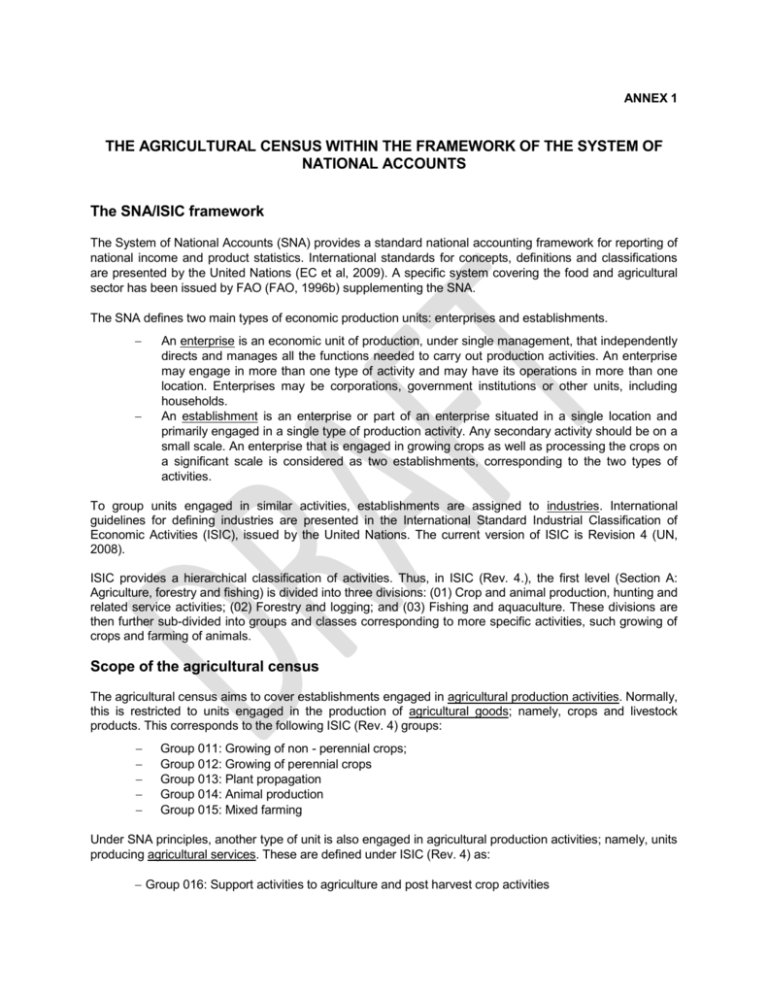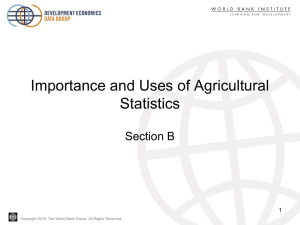SNA - Food and Agriculture Organization of the United Nations
advertisement

ANNEX 1 THE AGRICULTURAL CENSUS WITHIN THE FRAMEWORK OF THE SYSTEM OF NATIONAL ACCOUNTS The SNA/ISIC framework The System of National Accounts (SNA) provides a standard national accounting framework for reporting of national income and product statistics. International standards for concepts, definitions and classifications are presented by the United Nations (EC et al, 2009). A specific system covering the food and agricultural sector has been issued by FAO (FAO, 1996b) supplementing the SNA. The SNA defines two main types of economic production units: enterprises and establishments. An enterprise is an economic unit of production, under single management, that independently directs and manages all the functions needed to carry out production activities. An enterprise may engage in more than one type of activity and may have its operations in more than one location. Enterprises may be corporations, government institutions or other units, including households. An establishment is an enterprise or part of an enterprise situated in a single location and primarily engaged in a single type of production activity. Any secondary activity should be on a small scale. An enterprise that is engaged in growing crops as well as processing the crops on a significant scale is considered as two establishments, corresponding to the two types of activities. To group units engaged in similar activities, establishments are assigned to industries. International guidelines for defining industries are presented in the International Standard Industrial Classification of Economic Activities (ISIC), issued by the United Nations. The current version of ISIC is Revision 4 (UN, 2008). ISIC provides a hierarchical classification of activities. Thus, in ISIC (Rev. 4.), the first level (Section A: Agriculture, forestry and fishing) is divided into three divisions: (01) Crop and animal production, hunting and related service activities; (02) Forestry and logging; and (03) Fishing and aquaculture. These divisions are then further sub-divided into groups and classes corresponding to more specific activities, such growing of crops and farming of animals. Scope of the agricultural census The agricultural census aims to cover establishments engaged in agricultural production activities. Normally, this is restricted to units engaged in the production of agricultural goods; namely, crops and livestock products. This corresponds to the following ISIC (Rev. 4) groups: Group 011: Growing of non - perennial crops; Group 012: Growing of perennial crops Group 013: Plant propagation Group 014: Animal production Group 015: Mixed farming Under SNA principles, another type of unit is also engaged in agricultural production activities; namely, units producing agricultural services. These are defined under ISIC (Rev. 4) as: Group 016: Support activities to agriculture and post harvest crop activities This group includes activities incidental to agricultural production and activities similar to agriculture not undertaken for production purposes (in the sense of harvesting agricultural products), done on a fee or contract basis. Also included are post-harvest crop activities, aimed at preparing agricultural products for the primary market. These service activities are becoming increasingly important, but are generally not included within the scope of the agricultural census. The agricultural holding as an establishment Under SNA, an establishment in the agricultural industry (ISIC Groups 011, 012 013, 014 and 015) is one whose principal activity is in one of the designated ISIC groups. Such an establishment may also have a secondary activity not related to agriculture. Similarly, an establishment in a non-agricultural industry may have a secondary activity in agriculture. Thus, establishments in the five ISIC groups do not provide full coverage of all agricultural production activities. An agricultural holding is an economic unit of agricultural production under single management. If the principal economic production activity of the agricultural holding is agricultural production, the agricultural holding is an establishment in the agricultural industry. However, the two units are not the same if the agricultural production activity of the agricultural holding is a secondary activity of a non-agricultural establishment. Here, the agricultural holding may be considered as an establishment-like unit in the agricultural industry. For the purposes of the agricultural census, the agricultural holding is treated as being equivalent to an establishment unit under the SNA framework. Most agricultural production activities are undertaken by households. For the household sector, the enterprise is the agricultural production management unit in the household, and the agricultural holding (establishment) is the unit of agricultural production within the management unit. Thus, usually: There is only one management unit in the household and therefore the household itself is the enterprise. There is only one agricultural production establishment in the household and therefore, the agricultural holding is equivalent to the agricultural production activities of the household. However, there are some special cases. If two family units in a household manage agricultural production activities independently, each family unit corresponds to an enterprise (because they are separate agricultural management units). Each family unit (enterprise) contains one agricultural holding (establishment) unit. If a household undertakes agricultural production activities both on its own and in partnership with other households, there are two separate management units associated with the household, which therefore corresponds to two enterprises. Each enterprise unit contains one agricultural holding (establishment) unit. In SNA terms, an agricultural holding in the household sector, as an establishment unit, consists of the agricultural production activities of the household enterprise unit, plus any small-scale secondary activities. Any significant economic activities in the household enterprise unit outside the five ISIC groups covered by agricultural censuses are considered to be activities of other establishments. Thus, a household that engages in significant forestry activity as well as its primary agricultural activity consists of two establishment units: an agricultural establishment and a forestry establishment. Thus, data on forestry collected in agricultural censuses do not, technically speaking, relate to the agricultural holding as such, but to the enterprise unit of which the holding is a part. This helps to clarify the interpretation of non-agricultural data collected in the agricultural census; in other words, the agricultural census is collecting two types of data: (i) agriculture-related data about the holding (establishment); and (ii) other data about the household (enterprise) unit. One problem in linking the agricultural holding unit with the establishment unit is the single location concept in the definition of establishment. The land operated by an agricultural holding under single management often consists of more than one parcel. By definition, each parcel is usually in a different location (a parcel is a piece of land, of one tenure type, entirely surrounded by land with another type of tenure or land not operated by the holding). Thus, in principle, each parcel of land could be seen as corresponding to an establishment. In SNA, there is some flexibility in the interpretation of single location; for agricultural holdings, it may be interpreted more broadly as covering activities within a specific administrative unit such as a district or province. The agricultural holding definition refers to parcels sharing the same inputs such as labour; this limits the extent of geographical dispersion of land in a single holding and is consistent with the SNA establishment concept. Aquaculture Aquaculture data collected in the agricultural census relate to aquaculture activities carried out in association with the agricultural production activities of the agricultural holding, using the same inputs. In SNA terms, the agricultural and aquacultural activities are in different ISIC divisions, and conceptually, the two activities should be considered as different establishment units, even though they are closely related. However, if the aquacultural activity is small-scale compared with the holding’s principal agricultural production activity, it may be considered as a secondary activity of the agricultural holding as part of the agricultural industry. An aquacultural census covers aquacultural production activities, defined by ISIC (Rev. 4) as: Group 032: Aquaculture. The statistical unit for an aquacultural census is the aquacultural holding, defined as an economic unit of aquacultural production under single management. In SNA terms, an aquacultural holding is an establishment in the aquacultural industry; that is, in ISIC (Rev. 4) group 032. This is analogous to the concept of an agricultural holding in the agricultural industry. Conceptually, the agricultural census and the aquacultural census are separate censuses of different industries. However, they can be combined into a single field enumeration system as part of a census of agriculture and aquaculture. Other economic activities (Item 0108) Item 0108 in the list of items refers to activities, other than agricultural production on the holding, carried out by the enterprise of which the holding is a part. According to SNA principles, each type of economic activity in a given location is carried out by a separate establishment. Thus, if the household is also engaged in collecting forest products and operating a shop, then both these activities represent establishments. A household could also be engaged in agricultural production activities outside the holding; for example, if there are two holdings in a household or if the household is involved in a partnership agreement. All activities are classified according to ISIC (Rev. 4.) as follows: Other agricultural production activities: ISIC groups 011–015. Support activities to agriculture and post-harvest crop activities: ISIC Group 016 Hunting, trapping, and related service activities: ISIC Group 017. This group, together with Agricultural services (ISIC group 016) covers the rest of ISIC Division 01 (Crop and animal production, hunting and related service activities), not included within the scope of the agricultural census. Forestry and logging: ISIC Division 02. Fishing and aquaculture: ISIC Division 03. Manufacturing: ISIC Divisions 10–33. Wholesale and retail trade; repair of motor vehicles and motorcycles: ISIC Divisions 45–47. Accommodation and food service activities: ISIC Division 55-56. Other: all other ISIC classes not covered in the above.







